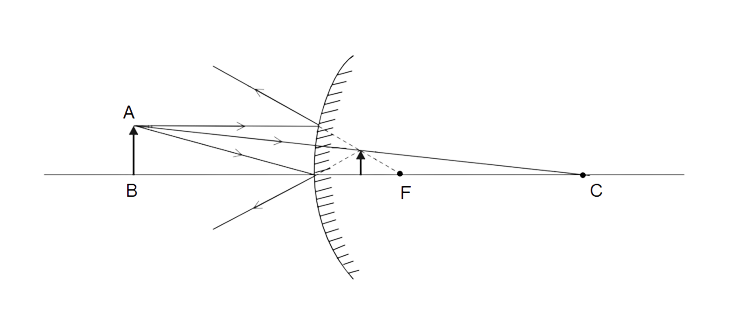
A short straight object of height \[100\,cm\] lies before the central axis of a spherical mirror whose focal length has absolute value \[\left| f \right| = 40\,cm\]. The image of the object produced by the mirror is of height \[25\,cm\] and has the same orientation as the object. One may conclude from the information:

A. image is real, the same side of the concave mirror.
B. image is virtual, opposite side of the convex mirror.
C. image is virtual, opposite side of the concave mirror.
D. image is real, same side of the convex mirror.
Answer
219.6k+ views
Hint: In this question, we are given with an object which lies before the central axis of a spherical mirror whose focal length has absolute value \[40cm\] and the image of the object produced by the mirror is of height\[25cm\], we need to find the nature of the image formed by the mirror, we will observe the position of the object and on that basis will find the image.
Complete step by step solution:
Given that the height of the object is \[100cm\]. Also it is given that the height of the image formed by the mirror is \[25cm\], which means the size of the object is reduced by \[25\% \]. Hence we can say the mirror is a convex mirror since a convex mirror bends the image, so the height gets reduced for the image formed. Now since we conclude that the mirror is a convex mirror and the image is upright as in the case of the object so we can say the image formed is virtual.
Therefore we can say option B. is correct, the image is virtual and on the opposite side of the convex mirror.
Note: The height of an image formed by the reflecting surface is always dependent on the position and the nature of the lens through which the light is passed.
Complete step by step solution:
Given that the height of the object is \[100cm\]. Also it is given that the height of the image formed by the mirror is \[25cm\], which means the size of the object is reduced by \[25\% \]. Hence we can say the mirror is a convex mirror since a convex mirror bends the image, so the height gets reduced for the image formed. Now since we conclude that the mirror is a convex mirror and the image is upright as in the case of the object so we can say the image formed is virtual.
Therefore we can say option B. is correct, the image is virtual and on the opposite side of the convex mirror.
Note: The height of an image formed by the reflecting surface is always dependent on the position and the nature of the lens through which the light is passed.
Recently Updated Pages
Electricity and Magnetism Explained: Key Concepts & Applications

JEE Energetics Important Concepts and Tips for Exam Preparation

JEE Isolation, Preparation and Properties of Non-metals Important Concepts and Tips for Exam Preparation

JEE Main 2021 July 25 Shift 1 Question Paper with Answer Key

JEE Main 2021 July 22 Shift 2 Question Paper with Answer Key

States of Matter Chapter For JEE Main Chemistry

Trending doubts
JEE Main 2026: Application Form Open, Exam Dates, Syllabus, Eligibility & Question Papers

Understanding Uniform Acceleration in Physics

Derivation of Equation of Trajectory Explained for Students

Hybridisation in Chemistry – Concept, Types & Applications

Understanding the Angle of Deviation in a Prism

Understanding Atomic Structure for Beginners

Other Pages
JEE Advanced Marks vs Ranks 2025: Understanding Category-wise Qualifying Marks and Previous Year Cut-offs

Dual Nature of Radiation and Matter Class 12 Physics Chapter 11 CBSE Notes - 2025-26

How to Convert a Galvanometer into an Ammeter or Voltmeter

Understanding Centrifugal Force in Physics

JEE Main Marking Scheme 2026- Paper-Wise Marks Distribution and Negative Marking Details

Degree of Dissociation: Meaning, Formula, Calculation & Uses




